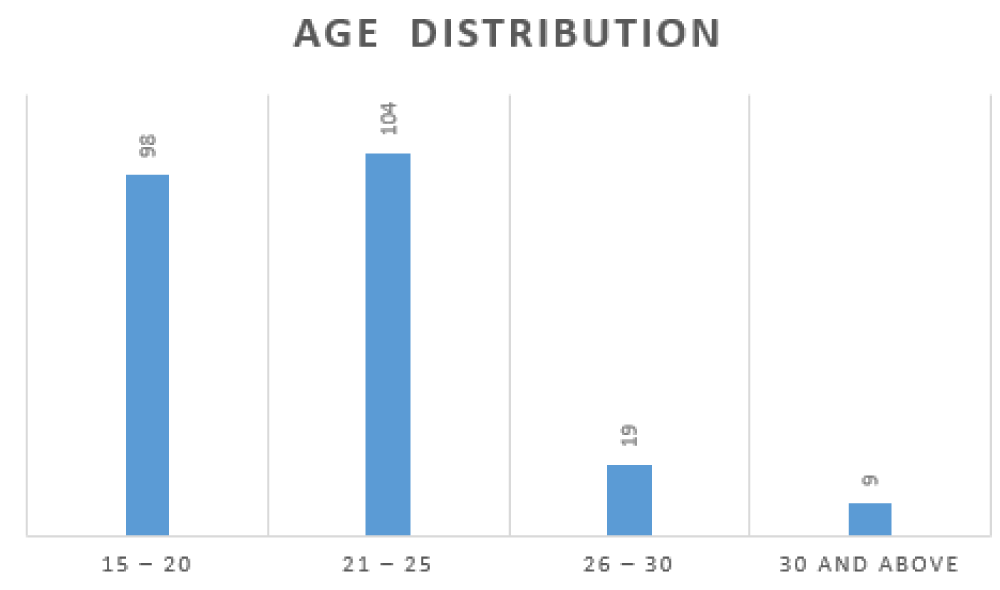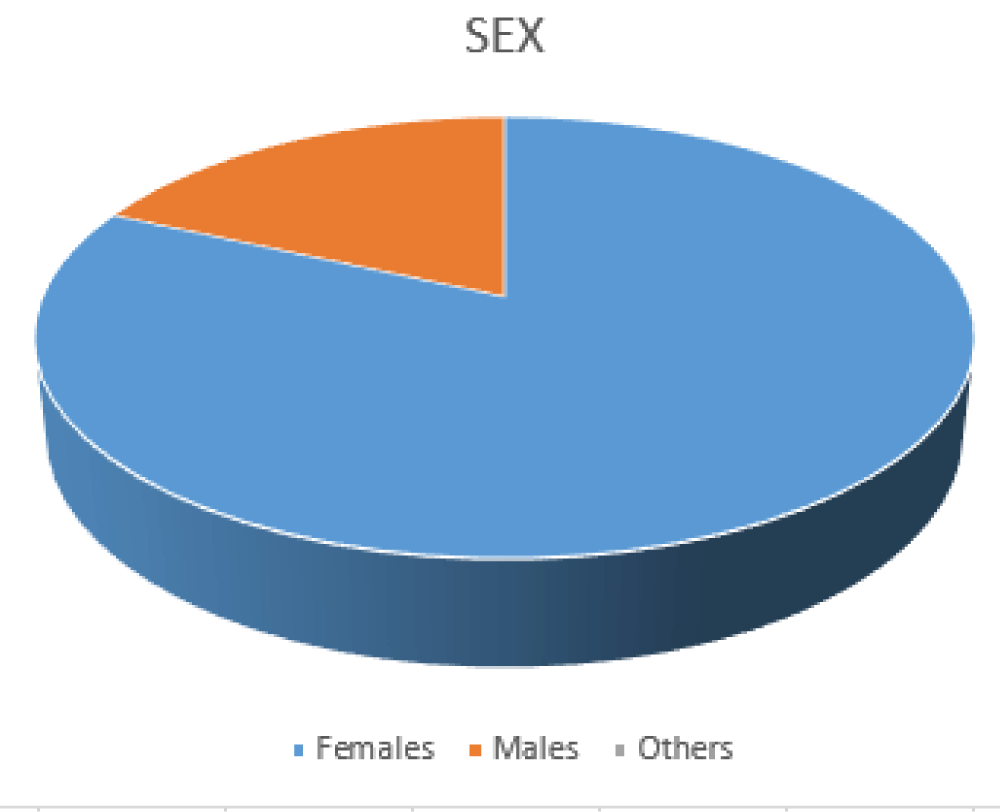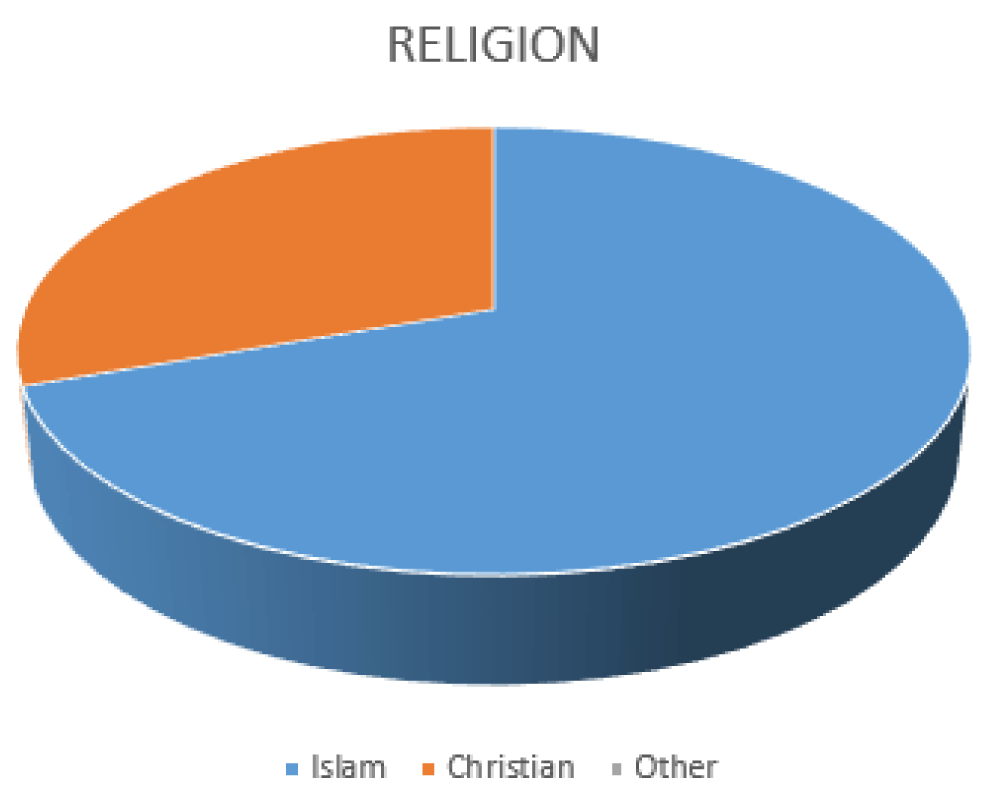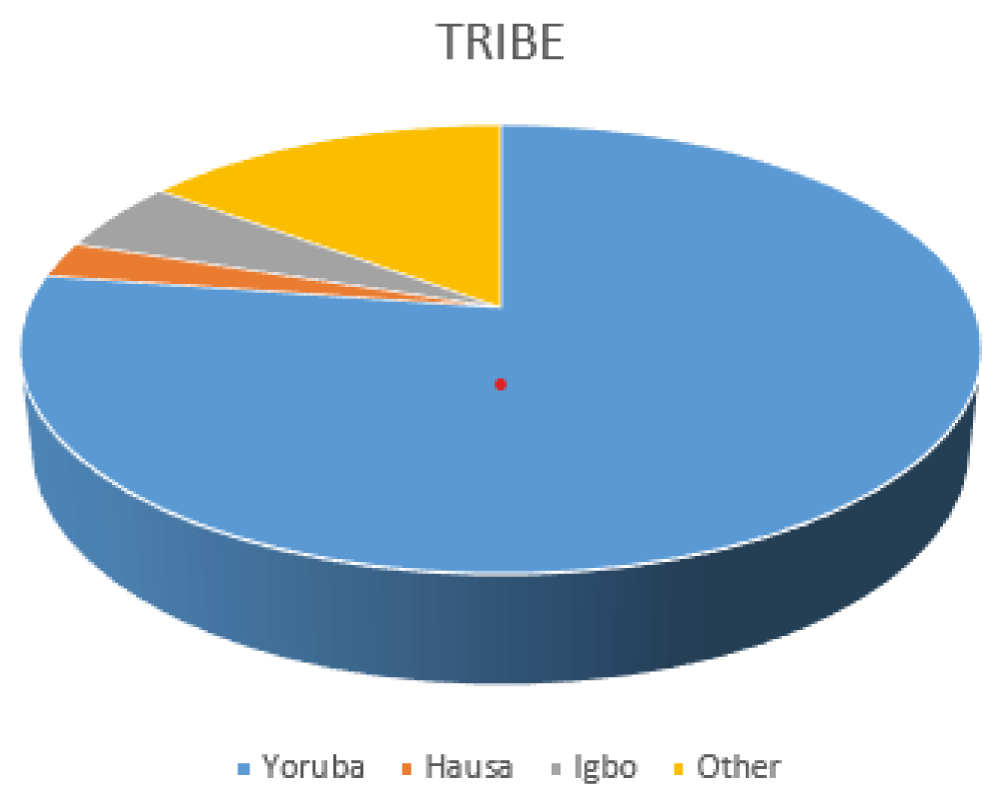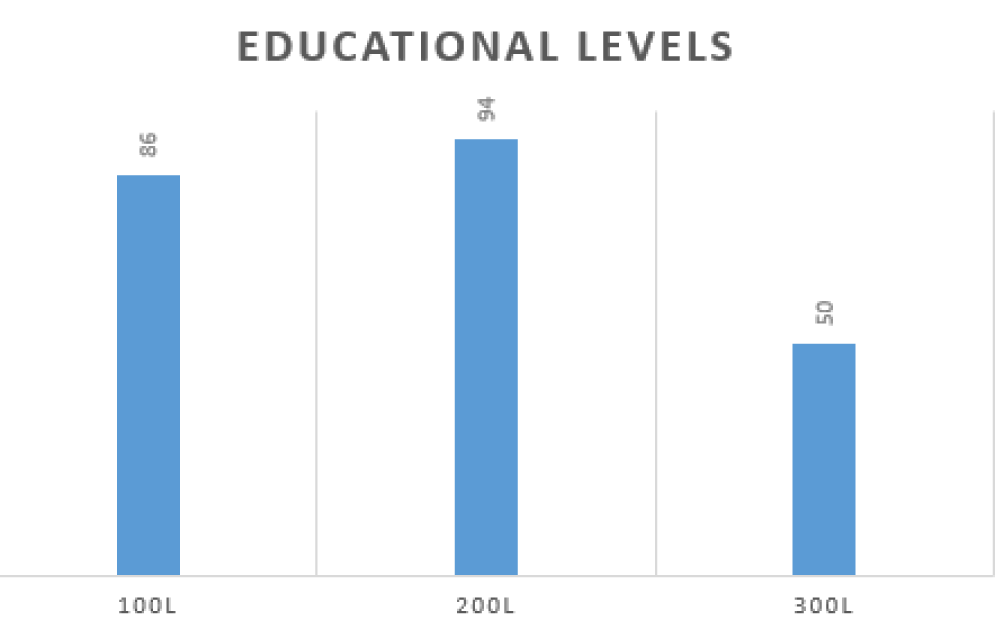More Information
Submitted: May 06, 2025 | Approved: June 11, 2025 | Published: June 12, 2025
How to cite this article: Opeyemi AI, Ridwanullah A, Suleiman EM, Ayoade IM, Ayinla K, Ayinla IA, et al. Knowledge, Attitude and Awareness of Adolescence Hypertension among Student Nurses in a Tertiary Institution in Kwara State. Arch Case Rep. 2025; 9(6): 193-200. Available from:
https://dx.doi.org/10.29328/journal.acr.1001145
DOI: 10.29328/journal.acr.1001145
Copyright license: © 2025 Opeyemi AI, et al. This is an open access article distributed under the Creative Commons Attribution License, which permits unrestricted use, distribution, and reproduction in any medium, provided the original work is properly cited.
Keywords: Adolescent hypertension; Knowledge; Attitude; Awareness; Student nurses; Preventive measures; Nursing education
Knowledge, Attitude and Awareness of Adolescence Hypertension among Student Nurses in a Tertiary Institution in Kwara State
Abdulmumeen Ibrahim Opeyemi1*, Ahmad Ridwanullah2, Eze Muhammed Suleiman3, Ibraheem Mulikat Ayoade4, Kazeem Ayinla5, Imam Abubakar Ayinla6, Abubakar Maryam Kehinde6, Imam Rasheedah Toluwase6, Ibrahim Ahmed Orelope7 and Abiodun Lawal Sebioniga6
1Department of Nursing Sciences, College of Health Sciences, Al Hikmah University, Ilorin, Nigeria
2Kwara State College of Nursing Sciences, Oke Ode, Nigeria
3Department of Human Anatomy, Faculty of Basic Medical Sciences, College of Health Sciences, Al-Hikmah University, Ilorin, Nigeria
4Faculty of Nursing Sciences, Al Hikmah University, Ilorin, Nigeria
5Department of Nursing Sciences, Federal University of Health Sciences, Ila Oragun, Nigeria
6Faculty of Nursing Sciences, Al Hikmah University, Ilorin, Nigeria
7Department of Nursing Services, University of Ilorin, Teaching Hospital, Nigeria
*Address for Correspondence: Abdulmumeen Ibrahim Opeyemi, Department of Nursing Sciences, College of Health Sciences, Al Hikmah University, Ilorin, Nigeria, Email: [email protected]
Background: Adolescent hypertension is an emerging public health concern with serious long-term cardiovascular risks if left untreated. Early identification, awareness, and preventive measures are essential in managing this condition, particularly among healthcare providers who play a critical role in health promotion and patient education.
Aim: This study aims to assess the knowledge, attitude, and awareness of adolescent hypertension among student nurses at Kwara State College of Nursing, Oke-Ode, Kwara State. The research seeks to identify the students’ understanding of adolescent hypertension, their attitude towards its prevention, and their awareness of its long-term health consequences.
Methodology: A descriptive cross-sectional design was employed, utilizing a structured questionnaire distributed to 255 students which 230 responses were retrieved from the respondents. The questionnaire assessed demographic information, knowledge of adolescent hypertension, attitudes towards its prevention, and awareness of its risks. Data were analyzed using descriptive and inferential statistics to determine the level of knowledge, attitudes, and awareness.
Results: The findings revealed that while a significant proportion of students demonstrated moderate knowledge of adolescent hypertension, critical gaps were observed in their understanding of specific risk factors, complications, and management strategies. Although most participants exhibited positive attitudes towards adopting healthy lifestyles to prevent hypertension, only a minority actively practiced regular physical activity or followed a healthy diet. Awareness of the importance of regular blood pressure monitoring was high, yet inconsistent in practice among the students.
Conclusion: The study concludes that although student nurses have a basic understanding of adolescent hypertension, there is a need to improve their knowledge and practical engagement in preventive measures. Efforts to strengthen nursing education through enhanced curriculum content, practical training, and health promotion activities are recommended to better prepare student nurses for addressing adolescent hypertension in clinical settings.
Adolescence Hypertension refers to elevated blood pressure in individuals aged 10 to 19 years [1]. It is typically diagnosed when a teenager’s blood pressure readings are consistently at or above the 95th percentile for their age, sex, and height on at least three separate occasions [2] this condition is increasingly being recognized as a significant health issue due to its association with long-term cardiovascular risks. Elevated blood pressure during adolescence can lead to serious health problems such as heart disease and stroke in later life if not properly managed [3].
Hypertension, commonly known as high blood pressure, is a significant public health issue globally. It is a major risk factor for cardiovascular diseases, which are the leading cause of mortality worldwide [4]. While Adolescence Hypertension is often associated with adults, its prevalence among adolescents has been rising, signaling an urgent need for early intervention and prevention strategies [5].
Adolescents with Adolescence Hypertension are at an increased risk of continuing to have high blood pressure into adulthood, which can lead to severe health complications such as stroke, heart disease, and kidney failure [6]. Early detection and management are crucial, and nursing students, as future healthcare providers, play a pivotal role in addressing this issue. Therefore, their knowledge, attitude, and awareness regarding Adolescence Hypertension are critical for effective health promotion and disease prevention.
Studies have shown that knowledge gaps and misconceptions about Adolescence Hypertension can impede effective management and control of the condition. For instance, a study by [7] found that even among healthcare professionals, there is often inadequate knowledge about the risk factors and long-term implications of Adolescence Hypertension. This lack of awareness can translate into poor health outcomes for patients.
Attitudes towards Adolescence Hypertension prevention and management also significantly impact health behaviors. Nursing students’ perceptions and beliefs about the importance of lifestyle modifications, such as diet and exercise, can influence their willingness to engage in and promote these practices [8]. Moreover, their awareness of the risks associated with untreated Adolescence Hypertension is essential for fostering a proactive approach to health care.
In Nigeria, Adolescence Hypertension is a growing concern, with increasing rates of the condition observed among both adults and adolescents. The socio-economic and cultural context in Nigeria poses unique challenges and opportunities for Adolescence Hypertension education and management [9]. Understanding the specific knowledge, attitudes, and awareness of nursing students in this context can provide valuable insights for designing effective educational interventions.
According to [10], Adolescence Hypertension in children and adolescents has become a major public health problem worldwide. However, due to the lack of epidemiological data and the absence of clear risk factors for Adolescence Hypertension, it is likely that many pediatric hypertensive patients are not correctly identified and given adequate attention.
Adolescence Hypertension is a major risk factor for cardiovascular disease and other complications associated with increased morbidity, global mortality, and health costs. Globally, there are no specific statistical values on the mortality rate of Adolescence Hypertension, however hypertension generally accounts for 7.5 million deaths per year and is a major risk factor for heart disease, 51% of deaths due to stroke, and triggers for kidney disorders. It is important to note that this figure refers to hypertension in the general population and is not exclusive to adolescents. However, adolescent hypertension is increasingly recognized as a significant precursor to adult hypertension and cardiovascular disease [11]. Adolescence Hypertension in adolescence significantly contributes to morbidity and mortality. While specific global mortality data for Adolescence Hypertension are sparse, the condition is a major risk factor for premature cardiovascular diseases, which are leading causes of death globally.
Adolescence Hypertension is not an isolated phenomenon in adolescent populations and needs to be treated in the same way as other diseases of a chronic nature. The strategy of prevention and treatment in the light of available research should be long-term and focused on reducing the number of complications in adulthood [12].
According to [13], there is a lack of comprehensive understanding among student nurses regarding the unique aspects and implications of Adolescence Hypertension in adolescents, leading to potential challenges in early detection and management. Negative attitudes or misconceptions held by student nurses regarding Adolescence Hypertension may influence their screening practices and willingness to intervene, potentially contributing to underdiagnose and under treatment [14]. Student nurses may receive inadequate training and educational resources on Adolescence Hypertension, resulting in gaps in knowledge and skills necessary for effective assessment, counseling, and management [15].
This study aims to assess the knowledge, attitude, and awareness of Adolescence Hypertension among students at Kwara State College of Nursing, Oke-Ode. By identifying gaps and strengths in their understanding, the research hopes to contribute to better educational strategies that can enhance Adolescence Hypertension prevention and management in the community.
Ethical consideration
This study adheres to strict ethical guidelines to ensure the protection and well-being of all participants. The following ethical considerations were addressed:
Informed Consent: Informed consent was obtained from all participants, ensuring that they are fully aware of the study’s purpose, procedures, potential risks, and benefits.
Confidentiality and anonymity: The confidentiality and anonymity of participants were strictly maintained. No personal identifying information was collected or recorded.
Ethical approval: Prior to data collection, an ethical approval letter was submitted to the college authority and the study protocol was reviewed and approved by the institutional ethics review board and relevant authority to ensure compliance with ethical standards.
Use of data: The data collected was used solely for the purpose of this study only. Results were reported in aggregate form to prevent identification of individual participants. Publications or presentations arising from this research adhered to ethical standards for reporting and dissemination.
By adhering to these ethical principles, the study aims to respect the rights and dignity of all participants while ensuring the integrity and validity of the research findings.
Research design
The study adopts a descriptive cross-sectional survey design, which is suitable for identifying the current status of Knowledge, Attitude and Awareness of Adolescence Hypertension among Student Nurses in Kwara State College of Nursing Oke-Ode. This design allows for the collection of data at a single point in time from a sample that represents the larger population of interest.
Research setting
This research was conducted in Kwara State colleges of Nursing Sciences Oke-Ode the college was commissioned on 14th of September, 2021 by His Excellency Alhaji Abdulfatath Ahmed, a former Executive Governor of Kwara state.
Location: The Kwara State College of Nursing, Oke-Ode, is located in the town of Oke-Ode within Ifelodun Local Government Area. Oke-Ode is situated in the southwestern part of Nigeria, specifically within Kwara State.
Coordinates: The exact geographical coordinates of the college may vary, but it is generally located within Latitude 8.0167° N and Longitude 4.5500° E, as this is the general location of Oke-Ode town.
Accessibility: The College is accessible via road transportation, with Oke-Ode town being connected to major cities and towns in Kwara State and neighboring states through a network of roads.
Campus size: The size of the college campus typically includes administrative buildings, lecture halls, laboratories, libraries, hostels or accommodation facilities for students, and recreational areas.
Topography: The topography of the college campus is similar to that of Oke-Ode town, characterized by relatively flat terrain with occasional low hills and gentle slopes.
Infrastructure: The college campus is equipped with basic infrastructure to support academic and administrative activities. This includes library, water supply, and sanitation facilities.
Surroundings: The college campus is surrounded by the natural landscape of Oke-Ode town, which includes savanna grasslands, shrubs, and trees. The surrounding area may also feature agricultural fields, residential areas, and other educational institutions.
Community engagement: The College plays a significant role in the community, providing educational opportunities for aspiring nurses from Oke-Ode town and surrounding areas. It also contributes to the healthcare sector by producing qualified nursing professionals to serve in various healthcare facilities across Kwara State and beyond.
Overall, the Kwara State College of Nursing, Oke-Ode, is strategically located in Oke-Ode town within Ifelodun Local Government Area of Kwara State, Nigeria. It serves as a hub for nursing education and training, contributing to the development of healthcare services in the region. Limitations of the research setting includes constrains related to time, network and availability of light.
Target population
The target population for this research was the nursing students in Kwara State College of Nursing Oke-Ode. According to the registry department of Kwara State College of Nursing Oke-Ode (2024), the total population of the students in the college was 700 which are distributed across three years/ levels as follows: First year 256 students, Second Year 291 students and Third year 153 students respectively. The inclusion of nursing students from different academic levels ensures a diverse representation, allowing for comprehensive insights into the Knowledge, Attitude, and Awareness of Adolescent Hypertension within the students. By targeting this specific population, the research was able assess the readiness of future healthcare professionals to address the challenges posed by Adolescent Hypertension, thus contributing to the development of effective educational interventions and healthcare policies tailored to this demographic group.
Sample size
The sample size for the research was determined using Taro Yamane’s formula for calculating sample size. The Taro Yamane’s statistical formula is stated as follows;
n = the sample size,
N = population size (N = 700)
e = Margin of error, e = 0.05 based on the research condition.
n = 254.545 ≈ 255
Therefore, the sample size for this study was 255 nursing students using Taro Yamane Formula.
Inclusion criteria
Enrollment atatus: Only students currently enrolled in Kwara State Colleges of Nursing Oke Ode.
Program level: Students at any level of their nursing program (e.g., first year, second year and third year).
Willingness to participate: Students who voluntarily agree to participate and provide informed consent.
Attendance: Students who have attended classes regularly during the academic term being studied.
Exclusion criteria
Non-enrollment: Individuals who are not students of Kwara State Colleges of Nursing Oke Ode.
Temporary enrollment: Students who are absence or have withdrawn from the program.
Non-consent: Students who do not consent to participate in the study.
Incomplete responses: Students who do not complete the survey or provide insufficient data for analysis.
Sample and sampling technique
In this study, a multistage sampling technique incorporating stratified sampling, systematic sampling, and simple random sampling methods was employed to select representative sample of 240 student nurses at Kwara State College of Nursing, Oke-Ode.
Population and stratification
According to the College Registry Department (2024), the total population of student nurses at the college is approximately 700, divided across three academic years: first-year with population of 256, second-year with population of 291, and third-year with population of 153 students.
To achieve a representative sample of 255 students from a total population of 700 students at Kwara State College of Nursing Oke-Ode, a multistage sampling technique was employed. This approach incorporates stratified sampling technique, systematic sampling technique, and simple random sampling technique to ensure a balanced and comprehensive selection process.
Stratified sampling: The student population was divided into three strata based on academic year: first-year, second-year, and third-year students, the sample size for each of the academic years were calculated using the formula where; x student population in each year, y total population of the students and N sample size each stratum then consists of year one; 93, year two; 105 and year three; 57 students respectively.
Systematic sampling: Within each stratum, a systematic sampling method was applied. A list of all students in each academic year was created, and every nth student was selected.
Simple random sampling: To further refine the selection within each stratum, simple random sampling technique was used. A random number generator was applied to select the specific students from the systematically sampled list, ensuring that the final sample is free from any selection biases.
This multistage sampling approach was chosen for its practicality and ability to capture a diverse and representative sample of the student population. By integrating stratified, systematic, and simple random sampling techniques, the study effectively minimized sampling bias and ensured the reliability and validity of the research findings.
Instrumentation
The research adopts questionnaire method as the instrument for data collection. The questionnaire was a close ended question which the respondents were only limited or confined to options given by the researcher.
The questionnaire is section into for section with the sections entailing questions to address different variable covering the demographic data of the respondents, the knowledge of the respondents, attitude and awareness of the respondents.
The questionnaire employed a combination of multiple-choice and Likert-scale items. For transparency and reproducibility, the full questionnaire is provided as supplementary material, which required the respondents to choose from options provided what best described their opinion. The questions were constructed to elicit relevant information pertaining to the research questions only.
Validation of the instrument
The validity of a test refers to the extent to which a test measures the variables under study. The drafted questionnaire was subjected to the supervisor and expert in nursing field for correction and approval before use for data collection. In essence, face and content validity was ensured by the supervisor’s validation.
Reliability of the instrument
The reliability of the instrument was determined using Test-Retest method where groups of students were selected from each academic years. These students are not included in the sample for the study. The selected students were administered the same questionnaire as the sample and the results were compared which shows high level of reliance.
Data collection procedure
The data for this study were collected through the administration of the instrument to the selected sample with the aid of Electronic Media.
After selection, the respondents’ contact information was duly collected with their full consent and understanding. Thereon the respondents where sent the link to the research instrument through which they are meant to enter their demographic data and give their responses to the various questions provided while ensuring their confidentiality and anonymity.
Data analysis
Data collected in this research were organized and analyzed critically, systematically, and objectively. Hence, the quantitative method of data analysis was adopted for effective analysis and explanation of the data. Descriptive statistical tools were used to analyze data on the demographic information of the respondents.
Data were presented in tabular format and percentages. For calculating the percentage, the formula below was adopted:
Where:
X = Number of respondents
Y = Number of total responders
Demography
From the table above it can be concluded that majority of the respondents are within the age range of 21-25 with frequency of 104 (45.22%), about 98 of the respondents falls within the age range of 15-20 (42.61%), and 26 – 30 age range with 19 respondents (8.26%) while the respondents that falls under age range of 30 and above are just 9 (3.91%) as shown in Figure 1.
Figure 1: Showing age distribution.
However, 188 respondents (81.74%) represent females and 42 (18.26%) respondents represent males, with 0 (0%) respondents representing other genders (Figure 2). Meanwhile, 69.57% of the respondents were Muslim (Islamic) by religion, and 30.43% were Christians, with 0% of respondents from other religions (Figure 3). Moreover, 77.40% of the respondents were Yoruba by tribe, 2.60% being Hausa by tribe and 5.22% Igbo by tribe while 14.78% represented respondents from other tribes (Figure 4).In addition. 37.39% of the respondents are at the 100 level of their education, 40.87% of the respondents are in the 200 level of their education, while 21.74% of the respondents are in their 300 level of their education (Figure 5).
Figure 2: Showing sex distribution.
Figure 3: Showing religious distribution.
Figure 4: Showing distribution among tribes.
Figure 5: Showing educational levels.
The study examined the Knowledge, Attitude, and Awareness of Adolescent Hypertension among Student Nurses at Kwara State College of Nursing, Oke-Ode. The findings highlight several key aspects of demographic data, awareness of causes, risk factors, lifestyle influences, and attitudes towards hypertension management and prevention.
The age distribution of the respondents revealed that the majority (45.22%) were between the ages of 21-25, followed by 42.61% in the 15-20 age range. This aligns with the study population, predominantly nursing students, who are typically in their late adolescence or early adulthood. The gender distribution showed a significant female majority (81.74%), consistent with other studies in the nursing field, which generally report higher female enrollment.
Although the World Health Organization (WHO) defines adolescence as the age range of 10–19 years, this study included nursing students aged 15 to 25 years. This inclusion reflects the demographic composition of Kwara State College of Nursing, where many students engaged in adolescent health education and clinical practice fall within the 21–25 age bracket. Including this group is justified as these young adults actively participate in healthcare delivery, including adolescent hypertension management, and their knowledge and attitudes significantly influence outcomes in adolescent populations.
However, a considerable portion of the respondents (40.87%) identified genetic factors as the primary cause of adolescent hypertension. This is consistent with the work of [16], which emphasized the influence of family history and genetic predisposition as significant causes of hypertension in adolescents. However, the role of stress was also highlighted by 30.87% of respondents, indicating the rising awareness of psychosocial stressors in developing hypertension, supported by studies like [17], which identified stress as a prevalent risk factor. Furthermore, risk factors for hypertension identified by the students reflect their awareness of contemporary health concerns. Most respondents (41.30%) believed that low cholesterol levels contribute to adolescent hypertension, contrasting with existing literature, where obesity and high sodium intake are more prominently cited as major risk factors for hypertension. This discrepancy suggests that while students are aware of some risk factors, there may be gaps in their understanding of cholesterol’s role. However, nearly half of the respondents (49.13%) believed that a sedentary lifestyle is most strongly associated with the development of hypertension, which aligns with the research of [18], highlighting physical inactivity as a significant risk factor for cardiovascular diseases among Nigerian youth. However, the low percentage (29.13%) of students who reported engaging in regular physical activity points to a disconnect between knowledge and practice, mirroring findings from previous studies [19], which indicated low physical activity levels among health students despite their awareness.
A large proportion of the respondents (63.49%) emphasized the importance of dietary habits in preventing adolescent hypertension, aligning with research by [20], which found diet modification to be a critical component of hypertension prevention. However, it is concerning that 38.26% of respondents only sometimes engage in physical activities, suggesting the need for interventions to encourage more consistent healthy behaviors.
Furthermore, the belief in the importance of stress management (agreed by 80.30% of the respondents) reflects the growing recognition of the role of mental health in hypertension prevention. This corresponds with studies like those by [21], which emphasized the importance of stress reduction in the management of adolescent hypertension.
The majority of respondents (60%) indicated that they would likely seek medical help if they suspected they had hypertension, highlighting a positive health-seeking attitude. This is further supported by the belief of 75.22% of respondents that early intervention can prevent complications associated with hypertension. These findings are consistent with [22], who found that nursing students tend to show high levels of health-seeking behavior compared to non-health students.
However, there were mixed responses regarding hypertension’s symptoms and complications, with only 39.57% of respondents identifying headaches as the most common symptom. A significant proportion (26.09%) noted that hypertension could often be asymptomatic, which is in line with the literature describing hypertension as a “silent killer” because it frequently presents with no symptoms until complications arise. This finding is consistent with previous studies [23], which observed that a lack of awareness about the asymptomatic nature of hypertension leads to delayed diagnosis and management. In addition, an overwhelming majority of the respondents (74.35%) acknowledged the importance of regular blood pressure monitoring for overall health, which is consistent with national and global guidelines recommending regular check-ups, particularly in high-risk populations. Despite this, 74.35% of respondents admitted that they do not consistently monitor their blood pressure, which echoes findings from [24], where a gap was observed between awareness and the practical application of preventive measures.
The current study did not collect specific data on participants’ practical experience with blood pressure measurement or knowledge about different BP devices and measurement protocols. Future studies should incorporate these aspects to better assess student nurses’ preparedness for clinical hypertension screening and management.
The findings from this study highlight that while student nurses have a foundational understanding of adolescent hypertension, there is room for improvement in areas such as the identification of risk factors, complications, and management strategies. Despite positive attitudes towards healthy lifestyles, these attitudes are not always translated into action, possibly due to limited personal motivation or external barriers. The study underscores the critical need for reinforcing practical training on adolescent hypertension and the role of preventive measures in its management.
Moreover, the awareness of the importance of regular blood pressure monitoring is encouraging, but practical implementation remains a challenge. Therefore, addressing the gaps in knowledge and ensuring consistent practices are essential in preparing student nurses to effectively contribute to the prevention and management of adolescent hypertension in clinical settings.
The current study did not collect specific data on participants’ practical experience with blood pressure measurement or knowledge about different BP devices and measurement protocols. Future studies should incorporate these aspects to better assess student nurses’ preparedness for clinical hypertension screening and management.
- Hanssen H, Streese L, Vilser W. Retinal vessel diameters and function in cardiovascular risk and disease. Prog Retin Eye Res. 2022;91:101095. Available from: https://doi.org/10.1016/j.preteyeres.2022.101095
- Dalwood P, Marshall S, Burrows TL, McIntosh A, Collins CE. Diet quality indices and their associations with health-related outcomes in children and adolescents: an updated systematic review. Nutr J. 2020;19:118. Available from: https://doi.org/10.1186/s12937-020-00632-x
- Harvard Gazette. Study signals heart trouble for young adults [Internet]. 2023 [cited 2024 May 24]. Available from: https://news.harvard.edu/gazette/story/2023/10/study-signals-heart-trouble-for-young-adults/
- World Health Organization. Hypertension [Internet]. 2021 [cited 2024 May 24]. Available from: https://www.who.int/news-room/fact-sheets/detail/hypertension
- Freedman DS. A closer look at the childhood obesity epidemic. Nat Med. 2017;23(4):413–4.
- Flynn JT, Kaelber DC, Baker-Smith CM, Blowey D, Carroll AE, Daniels SR, et al. Clinical practice guideline for screening and management of high blood pressure in children and adolescents. Pediatrics. 2017;140(3):e20171904. Available from: https://doi.org/10.1542/peds.2017-1904
- Chorin E. Trends in adherence to the hypertension clinical guidelines and control rates over a decade. Am J Hypertens. 2018;31(6):600–6.
- Kumar N, Singh A. Knowledge and attitude regarding hypertension among adults residing in selected rural area of Delhi. Indian J Public Health Res Dev. 2019;10(2):429–34.
- Adeloye D, Basquill C, Aderemi AV, Thompson JY, Obi FA. An estimate of the prevalence of hypertension in Nigeria: A systematic review and meta-analysis. J Hypertens. 2015;33(2):230–42. Available from: https://doi.org/10.1097/hjh.0000000000000413
- Huang Y, Zheng H, Qin S, Chen C, Su D, Ye B, et al. Prevalence and risk factors of hypertension in adolescents: A cross-sectional study based on junior high schools in southwest China. 2022:1–18. Available from: https://doi.org/10.21203/rs.3.rs-2194101/v1
- Sembiring LGB, Utari DM. Prevalence and risk factors of hypertension among adolescents aged 18 to 21 years in Indonesia. Int Conf Public Health Proc. 2023;4(02):Article 02. Available from: https://doi.org/10.26911/the6thicph-FP.01.10
- Wieniawski P, Werner B. Prediction of the hypertension risk in teenagers. Cardiol J. 2022;29(6):994–1003. Available from: https://doi.org/10.5603/CJ.a2020.0079
- El-Wajeh YA. Knowledge, attitude, and practices of hypertensive adolescents towards their disease in Jordan. Int J Adolesc Med Health. 2019;31(6):1–7.
- Giri PA, Baviskar MP, Phalke DB. Assessment of knowledge and attitude about risk factors and complications of hypertension among the nursing students of Pravara Institute of Medical Sciences Loni, Maharashtra, India. Int J Community Med Public Health. 2017;4(11):4026–31.
- Alnasir FA. Knowledge and practices of nurses regarding hypertension management in Riyadh, Saudi Arabia. Open Access Maced J Med Sci. 2020;8(E):80–6.
- Eze CD, Onuoha PC, Nwankwo JO. Genetic predisposition and family history as major factors influencing adolescent hypertension in Nigeria. West Afr J Med Sci. 2021;35(4):210–22.
- Adeyemo TO, Ojo AO, Salami KA. Psychosocial stressors and hypertension risk among adolescents in Nigeria: A cross-sectional study. Niger J Cardiol. 2019;16(2):102–10.
- Oyeyemi AL, Adeboye OB, Fakunle OO. Physical inactivity and its relationship with hypertension among Nigerian youth: A public health concern. Afr J Cardiovasc Health. 2018;11(3):88–96.
- Ajayi TO. Physical activity levels among health science students in Nigerian universities: Awareness versus practice. Afr J Health Sci. 2020;29(3):145–58.
- Awosan KJ, Ibrahim MT, Sani MM. Dietary patterns and hypertension risk among Nigerian adolescents: A hospital-based study. J Hypertens Nutr. 2019;14(1):33–41.
- Bello AO, Oladimeji TA, Abiodun MO. Stress management and its role in preventing hypertension: A review of literature. Niger J Public Health. 2022;17(2):75–89.
- Okafor UA, Nwachukwu AE, Okechukwu PN. Health-seeking behavior and hypertension management among nursing students in Nigeria. Int J Nurs Res. 2021;28(2):92–110.
- Musa HK, Lawal SA, Umar IO. The silent nature of hypertension and its implications on adolescent health awareness in Nigeria. J Clin Hypertens Res. 2020;12(1):55–63.
- Umeh AE, Nwankwo IA, Ibekwe JO. Awareness and compliance with blood pressure monitoring among student nurses in Nigeria. J Prev Med Public Health. 2021;26(1):40–58.
- Ogunyemi ES. Medical Surgical Nursing with Anatomy and Physiology. Osun State: Supermon Limited; 2021.
- Flynn JT, Falkner B. New clinical practice guideline for the management of high blood pressure in children and adolescents. Hypertension. 2017;70(4):683–6. Available from: https://doi.org/10.1161/hypertensionaha.117.10050
